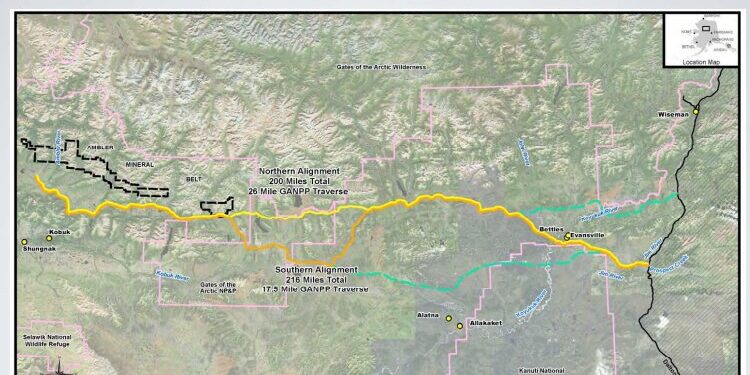The Alaska Industrial Development and Export Authority, AIDEA, meets in Kotzebue Wednesday with a game management group to discuss a proposed 220-mile road to a potentially lucrative copper deposit in the Northwest Arctic Borough.
If built, the Ambler Mining District Industrial Access Road (AMDIAR) would head west off the Dalton Highway near Evansville, pass through Gates of the Arctic National Preserve, and end in a remote area near three Upper Kobuk Valley communities near the resource.
“We’re already approaching 10 billion pounds of copper. That’s a major mine. So we don’t have a mine yet–but we certainly are getting something that has the size and potential to be a major mine,” said Ric van Nieuwenhuyse, head of the privately owned NovaCopper company.
“But, you won’t have a mining district without out road to it. So, that’s where AIDEA steps in,” Nieuwenhuyse told the Resource Development Council. He addressed them last April in Anchorage on the mining district, as well as the economic viability of a large-scale open-pit copper mine in the area.
AIDEA is spearheading the state’s push for the project. The road would be unprecedented in many ways, requiring construction of 15 long bridges over waterways in some of the state’s most remote wilderness. Though the project could take years, AIDEA is moving swiftly—a timetable one official called “daunting.”
In April, the agency began the long process of determining what the environmental impact of the road would be. $8.5 million for that study was set aside by lawmakers last month in the capital budget that passed in the Legislature, and will be part of what AIDEA sends to the feds if they apply for permits to begin work.
Karsten Rodvik is AIDEA’s director of external affairs. He says construction is still years away, and the process relies on input from those living where the road would pass by.
“We continue to work on the permit application process and are continually focused on a very active community involvement program,” Rodvik said. “We’re getting dates set in June for the Upper Kobuk communities and then throughout the summer we’re looking at establishing meeting dates for communities on the Koyukuk River.”
Feedback is important for AIDEA because under state law they’re required to have community support before developing projects.
But what exactly constitutes community support is not fully clear.
“The state does not have a good way to receive public comment,” said John Gaedeke, owner of a wilderness lodge close to the proposed road. Gaedeke started a petition opposing the road that’s gathered over 1,600 signatures online. He’s also the head of the Brooks Range Council, a group of business owners who charge that AIDEA and the state haven’t been open with the people who stand to be most affected by the project.
“The agencies have not connected [with] me at all, even though the road would pass within about eight miles of my family’s business,” Gaedeke said. “So, huge impact to the area the lodge is in–and the state has made no attempt to contact businesses affected in the area. That I’ve seen.”
But both AIDEA and NovaCopper tout local support for the road. At his April address, Nieuwenhuyse cited project backing from NANA, the borough’s Regional Corporation. Rodvik explained, “NANA supports AIDEA’s efforts to complete an Environmental Impact Statement to evaluate the potential for a road.”
NANA owns part of the Red Dog zinc mine 90 miles north of Kotzebue that’s often mentioned as a template for profitable mining projects in the state. A spokesperson for NANA said the organization supports the environmental impact statement process, but has not taken an official position on a road.
But Gaedeke—who is not a NANA shareholder and is unaffiliated with the corporation—and others opposed to the road say NANA doesn’t speak for them, and that their voices aren’t being heard. It’s a sentiment echoed by John Horner and the others on the Kobuk Traditional Council.
“We felt that they weren’t giving us much information to begin with,” Horner said in March after Kobuk passed a resolution against the AMDIAR. “As far as I am concerned, the Native Village of Kobuk is opposing the road.”
In Kobuk, opposition is tied to subsistence, with concerns the road will disrupt the Western Arctic Caribou Herd’s migration. After years of decline, the worry is more activity in the area will further diminish the herd, and upend its migratory patterns in the region.
Representing 42 Interior communities, the Tanana Chiefs Conference in March also formally opposed the project after all six communities along the proposed route drafted their own statements against it. But coming from a regional non-profit in an unorganized borough (as opposed to the Northwest Arctic Borough, which is organized–a distinction with legal bearing under state mandates) it’s unclear how AIDEA will weigh that opposition.
Today’s Unit 23 Working Group meeting will have state and federal, regional, and local representatives to hear AIDEA’s plan for the road ahead.
Editor’s note: a version of this story appeared online that made the NANA Corporation’s support for the AIDEA environmental impact statement process and road unclear; the above text reflects the corporation’s support for the for the environmental impact statement process only. In addition, the text has been clarified to reflect that NANA and John Gaedeke are unaffiliated.







